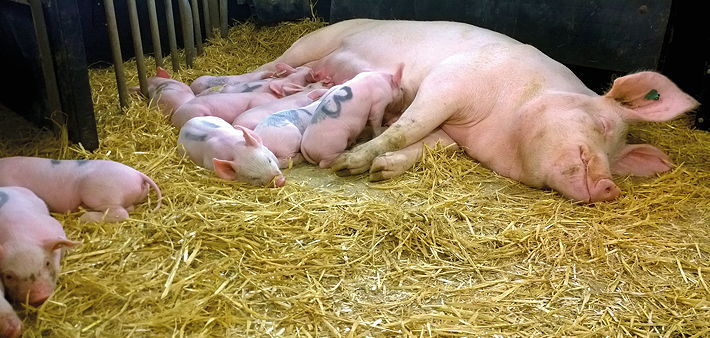New RSPCA welfare standards in relation to farrowing, and indoor free farrowing in particular, have been introduced. Available as an insert sheet ahead of the next full reprint of the RSPCA Welfare Standards for Pigs towards the end of 2016, they require full implementation by Freedom Food/RSPCA Assured members from December 2, 2015.
The new free farrowing standards are the culmination of several years of work by the RSPCA Farm Animals department. Since July 2010, the organisation has been engaging with producers (both Freedom Food and non-Freedom Food members), equipment manufacturers and researchers to ensure that these new standards are informed by the latest scientific research, as well as practical farming innovation and experience.
This process took some time as the RSPCA wanted to ensure that the new standards were robust and to avoid any further amendments in the near future. The draft standards were discussed at the inaugural meeting of the RSPCA Pig Standards Advisory Group meeting in May 2015. These discussions helped to ensure that the RSPCA welfare standards continue to be at the forefront of farm animal care and welfare, and are also achievable on commercial farms.
All Freedom Food members were informed of the new standards back in September 2015; members are always given at least three months notice of any changes. In terms of what the new standards mean for producers, full details can be found on the RSPCA website, but, in short, the main changes relate to minimum space requirements, flooring and ensuring that the sow cannot be confined for farrowing.
The 2014 version of the standards included an information box highlighting that, in addition to turning around, space is needed for increased activity, nursing, and separate dunging and feeding areas. This view was based on scientific research and practical experience, including that gained from the Defra-funded PigSAFE research programme and from producers already using indoor free farrowing systems.
The new standards require a bedded lying/nest area measuring at least 2.8 square metres (excluding the creep area) and a minimum total pen size, including the lying area/nest area, of 5.0 square metres. Any feeding stall provided is in addition to the minimum total pen size, that is it can’t be counted as part of the minimum pen size.
Research indicates that 2.8 square metres is the minimum space required for the sow to lie down laterally and for parturition. However, providing more space than this is key; an inability to separate the dunging area from the lying area/nest area or feeding area is likely to result in poor hygiene and resultant heath issues. Likewise, an inability to separate the lying area/nest area is likely to result in increased activity that could increase the risk of piglet crushing by the sow. Research indicates that a minimum of 5.0 square metres can satisfy these requirements as well as nest-site seeking behaviour.
As reported in Pig World in November 2014, another issue that was considered was the ability of some designs of pen, such as hinged-crate systems, to confine the sow. Like the partial stall ban on the Continent, the way in which such systems are used day-to-day is very difficult to assess as scheme field staff can only audit what they see on the day of the visit. We highlighted these concerns in the article, stating that in order to ensure compliance with the RSPCA’s requirement for non-confinement, the system must not be at all capable of being closed. For example, hinged-crate type systems must be permanently welded open. With this in mind the standard in relation to this requirement has been made clearer; the use of voluntary feeding stalls is permitted, but equipment that has the potential to confine the sow for farrowing must not be present.
With regards to floor type, the previous standard required that at least 75% of the floor pen is solid. Acknowledging that there can be benefits to allowing small perforations in the solid floor area in order to aid drainage and maintain a dry floor area, but needing to be mindful that too much void area can be uncomfortable and lead to difficulties maintaining suitable quantities of bedding, nesting and enrichment material, the nest/lying area, which must be solid, may have evenly distributed occasional perforations of up to 1%.
A full list of the new requirements can be found at: http://science.rspca.org.uk/sciencegroup/farmanimals/standards/pigs
A useful website with more general information on the topic of free farrowing has been developed by researchers at Scotland’s Rural College and the University of Newcastle see: http://www.freefarrowing.org




